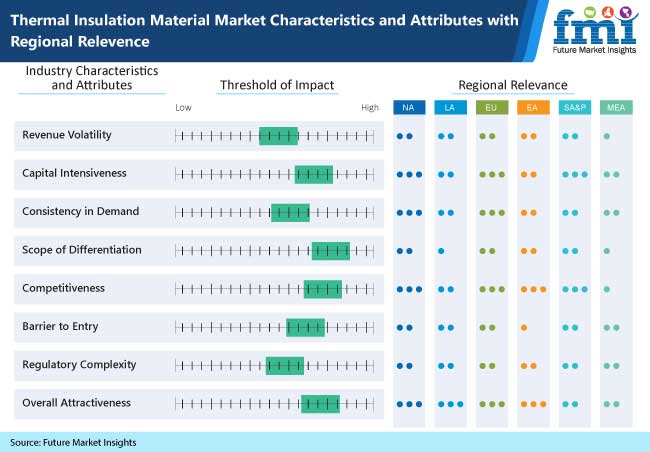Increasing demand from the construction and automotive industries for temperature control and energy efficiency is expected to fuel the demand for thermal insulation material. According to a new study by Future Market Insights (FMI), the market for thermal insulation material is set to rise steadily with a CAGR of over 4% through the end of the projection period in 2031.
The global demand for thermal insulation materials has rapidly gained traction owing to concerns associated with energy conservation. Strict government regulations associated with emissions from construction and automotive sector operations will drive long-term demand. In building operations, thermal insulation also provides benefits in supporting auxiliary building structures including roofs and flooring.
Niche applications in aerospace structures in addition to investments into smart city infrastructure are providing impetus to investments into product research & development, with a focus on material and design. End-user specific customization of product offerings on the basis of density, thermal conductivity, thickness and more will influence developments in the market for the foreseeable future.
Request a Complete TOC of this Report with figures:https://www.futuremarketinsights.com/toc/rep-gb-660
The growing demand for thermal insulation materials, particularly from emerging economies will offer key growth opportunities. On the other hand, the volatility in the pricing of raw material will challenge the growth of market participants. Market vendors are more likely to focus on the growth prospects in the fast-growing segments, while consolidating their positions in relatively slower-moving products.
Key Takeaways of Thermal insulation material Market Study
- Thermal insulation material sales to increase at above 4% CAGR through the assessment period.
- Backed by strong demand from the building and construction sector, insulation for 1ºC to 100ºC will hold the lead in 2021.
- Continuing issues in terms of energy supplies in the U.K. and Germany markets to register higher growth.
- United States is projected to record strong demand driven by rising applications in automotive sector.
- China will emerge as a high potential market, with investments in urbanization and manufacturing efforts in the country.
“Thermal insulation materials find widespread applications in spacecraft, buildings, clothing, mechanical systems, and in automotive offerings among others. Customization on the basis of specific heat capacity, thickness, surface emissivity, thermal bridging, thermal conductivity, and density will support demand as per the requirements of the target area,” Says an FMI analyst.
Download Your Sample Copy of This Report:https://www.futuremarketinsights.com/reports/sample/rep-gb-660
Developments in Green Construction Set to Drive Growth
According to FMI, thermal insulation material has immense scope for application in the building and construction industry owing to the increased focus in the sector on resource efficient and environment friendly materials. Also, there is a substantial growth in the construction of green buildings around the world owing to volatility in high energy prices, and concerns associated with environmental impact, along with the health and comfort of occupants. In addition, green building rating systems implemented in developed regions across Europe and North America such as the Leadership in Energy and Environmental Design, are contributing to growth.
Who is Winning?
The global thermal insulation material market can be considered as moderately consolidated, with a few leading players accounting for a prominent share of the overall thermal insulation material market. Manufacturers are increasingly focused on investments into research and development aimed towards new product launches.
Key market participants including BASF SE, Asahi Kasei Corporation, Rockwool International A/S, E. I. du Pont de Nemours and Company, Bayer AG, Berkshire Hathway (Johns Manville), Dow Chemicals Company, Owens Corning, Saint Gobain S.A., and Kingspan Group PLC amongst others are also focusing on consolidating their presence in the global market by entering into strategic industry collaborations with other market participants.
Thermal Insulation Material Market Key Segments
Material Type
- Stone Wool
- Fiber Glass
- Plastic Foam
- Others
Temperature Range
- -160°C to -50°C
- -49°C to 0°C
- 1°C to 100°C
- 101°C to 650°C
Region
- North America (U.S. & Canada)
- Latin America (Mexico, Brazil, Argentina, Chile, Peru, & Rest of LATAM)
- Western Europe (Germany, U.K., France, Italy, Spain, BENELUX, Nordic, & Rest of W. Europe)
- Eastern Europe (Russia, Poland, CIS Countries and Rest of E. Europe)
- Middle East and Africa (GCC Countries, Turkey, South Africa, Israel, & Rest of MEA)
- Japan
- Asia Pacific excluding Japan (China, India, ASEAN, South Korea, Australia, & Rest of APEJ)
Want to Know More?
Future Market Insights has published a market research report on the thermal insulation material market that contains global industry analysis for 2016–2020 and opportunity assessment for 2021–2031. The report provides insightful analysis of the thermal insulation material market through three different segments – material type, temperature range, and region. The thermal insulation material market report further provides demand trends of different types across industry verticals, a comprehensive list of service providers in the market along with a detailed overview of the parent market.
Ask us your Any Queries About this Report: https://www.futuremarketinsights.com/askus/rep-gb-660
About Chemicals & Materials division of FMI
The Chemicals & Materials division at FMI offers distinct and pin-point analysis about the chemicals & materials industry. Coverage of the chemicals and materials market extends from commodity, bulk, specialty and petrochemicals to advanced materials, composites, and nanotechnology. The team also puts special emphasis on ‘green alternatives’, recycling and renewable technology developments, and supply-demand trade assessment. Our research studies are widely referred by chemical manufacturers, research institutions, channel partners, and government bodies for developing – ‘The Way Forward’.

